【高频对冲做市网格New】(HFT Market-Making矿机版)
一台私人USDT矿机
Hello~Welcome come to my channel!
欢迎各位交易者来到我的频道,我是作手君,一名Quant Developer,全栈开发CTA & HFT & Arbitrage等交易策略。 感谢FMZ平台,我会在我的量化频道多多分享量化开发相关内容,同各位交易者共同维护量化社区的繁荣。
更多信息,移步我的频道哦~在这等你来撩【作手君量化小屋】
各位交易者大家好,经过数个月的调试、优化与迭代,很高兴这款次高频Maker策略已经达到了较为稳定的层面并可以与大家见面,这是一款基于网格思想优化迭代的次高频挂单做市策略,通过不断在当前中间价格上下挂Ask(卖)与Bid(买)订单获取波动收益,提供相应的流动性。这款策略不是基于订单薄的超高频流动性做市策略,而是基于秒级的次高频挂单策略,因此门槛更低,普适性更强,对手续费敏感度更低且无需军备竞赛,更适合广大普通手续费账户的交易者使用体验,下面将对这款策略做详细的说明。
Plus:手动求生欲本款策略属于秒级次高频挂单策略,极限挂单也只达到5-10bp,各位大神欢迎多多指教
一,做市的基本概念与Crypto市场特性
高频做市(Market Making)策略是一种常见的量化交易策略,指的是一种分别建立限价买(Bid)卖(Ask)单,利用标的价格的上下波动触发限价单,通过买(Bid)卖(Ask)单的差价获取交易收益的策略。做市策略中重点关注的是限价单的数量和以及买卖单报价与中间价距离的设定,因而在各类经典的做市策略中,主要研究的是中间价的估算,进而在中间价两边合适的位置设置买单和卖单。
在一些流动性较好的标的资产的交易活动中,普通投资者可以通过提交市价单或者直接买卖标的资产或者相关衍生标的直接参与市场交易。这样的市场中存在较多的投资者,资产流动性好,只要投资者在合理的价位出价,很快就可以找到交易对手。但在一些流动性较差的资产上,由于种种原因,参与这些资产投资活动的交易者较少,想要对这些资产展开买卖活动的投资者很难正确认识到资产的真实价值,也很难找到合适的对手进行成交,这时候就需要借助做市商来为市场提供流动性了。
做市商在依赖于资产价格波动中高低价之间的差价获得收益。那么,这种买卖价差是如何形成的?Harold Demsetz, 1968研究了纽约股市的交易成本,研究中首次阐述了做市商买卖报价差的形成过程:供求的不平衡会导致价差产生,“买卖报价价差是有组织的市场为交易的即时性(immediacy)支付的加成”。做市策略通常在双边报价,通过成交价格在价差间的窄幅波动获利,而这里的窄幅一般只有1-2个价位,而非大方向性变化。根据市场有效理论,股票价格在市场有效的状态下为“随机游走”,价格的走向不可预测。然而长期跟踪研究发现,价格的长期走势具有“均值回归(Mean Reversion)”的特点。均值回归在理论上具有必然性,价格走势不可能只升不降或者只降不升,价格保持正收益率或负收益率称之为均值回避(Mean-aversion)。在均值回归理论中,均值回避的现象是暂时的,均值回归是必然的。资产价格偏离其内在价值的程度影响均值回归周期的长短。
在传统市场,通常普通交易者没有交易所的场内席位,其订单都是通过经纪商发送至中心化交易所,少量的经纪商与签约机构才有机会成为交易所做市商。但是在Crypto数字货币市场,每一个交易者都可以直接的连接交易所,门槛十分之低,并且一个散户和一个顶级机构在费率和API接口的使用上也并不像传统市场中差距如此之大。因此,在Crypto数字货币市场中,做市不是什么高深莫测的概念,可以说每一个交易者都可以成为做市者,市场也给予了每一个交易者这样的机会,只要你使用Maker限价订单,你就是流动性提供者,你就是一个个的做市者。
二,做市策略的分类与为什么散户无法参与超高频订单薄做市?
传统的做市策略主要分为订单薄做市与网格做市。订单薄做市主要通过Level2数据(包括每个订单的价格、数量和交易方向等信息与逐笔成交信息)来分析市场上的供需情况和价格水平,从而提供买卖报价。主要包括两大经典的高频做市模型——AS模型(Avellaneda, M., and S. Stoikov, 2008)和GP模型(Fabien Guilbaud and Huyen Pham, 2011)。AS模型着重考虑了库存的风险管理,研究了一个做市商在考虑了存货风险的前提下,单项标的资产报价中的最优决策——即在资产的“真实价格”两侧创建最优买卖单。GP模型假设做市商的目标是通过市价单和限价单,控制库存数量,实现在某个短期区间的收益最大化。通过Markov过程模拟中间价的变动,使用Cox过程模拟给定价差和限价时做市商的限价单成交情况,并结合Calibration程序估计转移矩阵和价差的密度参数等,最终形成一个以库存和价差变量为基础执行的动态操作系统。
订单薄做市对数理水平与市场微观结构认知要求较高,硬件设备也过于内卷,逐步发展成为高数理统计背景下的高计算机/网络性能与硬件优化的军备竞赛,通常为了几ms甚至ns的速度优化架构,并且都在追求顶级的资金费率以便弥补策略本身的损失,是散户与大众交易者无法参与的领域。不过正如我之前所说,只要是Maker挂单策略就为市场提供了流动性,在crypto市场人人都是做市者。普通散户与大众交易者可以通过本款次高频对冲网格策略,避开竞争红海,在次高频领域有利润的一席之地。
三,基于网格思路迭代开发的高频做市策略
网格交易的起源应该可以追溯到上世纪40十年代信息论之父——香农,大名鼎鼎的《信息论》作者香农,被称为以一己之力开启信息时代的巨佬。策略核心的假设与思想:市场是有效的,是随机游走的,并且是具有均值回归特性的。最简单的网格交易已难以长期稳定的获取收益,需要主观判断行情进行操作。如果将最简单的网格策略开发成高频做市策略,就需要对其交易成本与盈亏特性进行分析,逐一优化迭代,以便适应手续费加成下变换莫测的市场。下面着重介绍本款高频做市网格策略的优化与迭代方向,我们先对交易成本方面进行分析,知道了会存在哪些成本就有了优化的方向,主要有以下几个方面:
指令处理成本。指的是交易的手续费,如果是高频的交易会产生巨量的手续费,对策略的盈利状况造成大幅度影响,因此需要全部改为挂单Maker成交以便对手续费有更低的敏感度,为了节省挂单占用,本款策略采用虚拟挂单方式,每次只会在盘口上下挂买卖的少量单子,不会大面积挂单,以便降低保证金占用。本款高频网格做市策略约90%的单子为Maker单,普通费率下手续费支出约为利润的1/4至1/2。按参数与模式选择不同,月交易量约为本金的50-500倍。如果有0手续费那么这笔支出将会成为多余的利润。因此,如果有低费率甚至负费率账户盈利效果会更显著。
无存货成本。指的是行情波动自己手中却没有库存的损失成本。做市商之所以会产生盈利,是因为自己手中的多头库存会在不断的上涨中甩出,而空头库存会在不断的下跌中出货。而库存的积累需要挂单的被吃,如果挂单还未被吃掉就不断朝单方向移动,这时手中就无存货可以甩出,就赚取不到利润。针对如此痛点,本款策略会在手中无库存时,不断在盘口买一卖一挂单立马获取1份库存,再在相应处挂止盈单以获取一份的利润。
库存积累成本。相比起无存货成本,做市者更惧怕库存积累成本,具体指行情不断朝一个方向运行,手中的单边存货无法甩出造成的亏损。通常有以下解决方法:
■ 补仓时进行逐步加仓,以便快速拉低成本,在小反弹处甩出。不过此类方法也伴随更大的风险,如果短期无反弹会积累更多仓位,绝对不能无止境的加倍类似马丁,需要考虑如何把握加仓数量与账户风险之间的平衡与尺度至关重要。
■ 对单向库存进行管理,根据库存水平与风险偏好进行挂单调整。此类方法避免了极端亏损,控制住库存持有量,不足点为不如拉低成本那样容易甩出库存,时间成本更高。
■ 动态调整挂单间距与上下位置。依据波动性与趋势性调整挂单宽窄,并不平衡间距挂上下单。
■ 极端情况限制。在极端单边时进行时间等待、只平仓挂单等操作,以更小减少积累。
■ 进行对冲。对冲是一门生意,也是一门艺术,做市者可以使用的对冲包括:同品种对冲、跨品种对冲、根据趋势对冲单边、积累到阈值对冲、资产配置角度全品种统一对冲等。本策略目前使用同品种对冲,多品种对冲,进一步增加稳定性,降低单一行情与币种的影响。
■ 品种选择。做市商最喜欢参与者散户更多、流动性更好的市场。做市商最喜欢震荡,最不喜欢单边,3.12⁄5.19爆了太多合约做市商。本款策略已经迭代至极端情况也不会爆仓,2020-2023全部行情均可安稳度过,在之后的数据部分会给出详细展示。本策略也会有搭配的适合币种,用户也可根据市场原理自主挑选合适币种。
信息成本。普通的挂单网格做市没有融入额外市场信息,容易被知情交易者逆向选择,可以对其输入额外的α因子进行预测,预测分为方向性预测与是否挂单预测。方向性预测可根据额外因子信息进行方向判断,在趋势方向进行不平衡挂单或停止反向挂单。是否挂单预测根据额外信息判断是否进行做市,但不对做市方向进行判断。本款策略在进行开发迭代的过程中有尝试过加入预测因子,鉴于目前水平不足,预测能力不够强,加入后结果表明似乎聪明反被聪明误,什么都不预测比进行预测效果更好(目前高频级别预测水平不足)。同时,预测与额外因子信号的输入就会产生路径依赖,预测如果优秀就会大幅度增强,同样的预测如果不令人满意就会其鲁棒性与反脆弱性就会降低。综上所述,目前未进行更多的额外预测,之后有机会会持续迭代优化。
四,策略绩效与各行情下盈亏特性展示
第三方实盘绩效
(注:为避免自画曲线,同步展示币COIN第三方实盘平台绩效,展示账户为币安普通费率账户,若为市商账户绩效有一倍以上提升.)
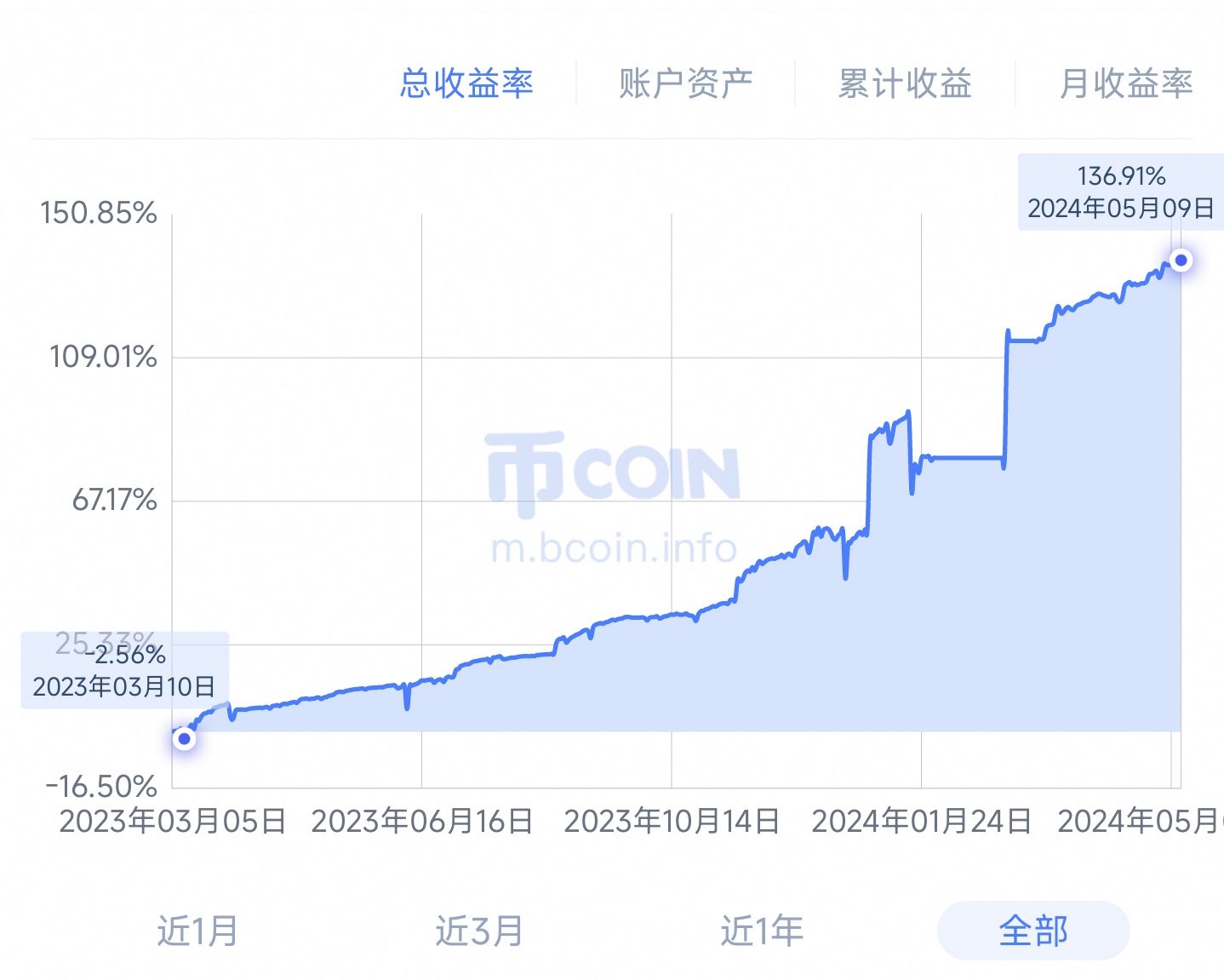
历史回测绩效 (注:沙盘回测采用tick数据,手续费Maker:0.02%/Taker:0.05%)
部分单品种展示(实盘以多品种对冲为主):
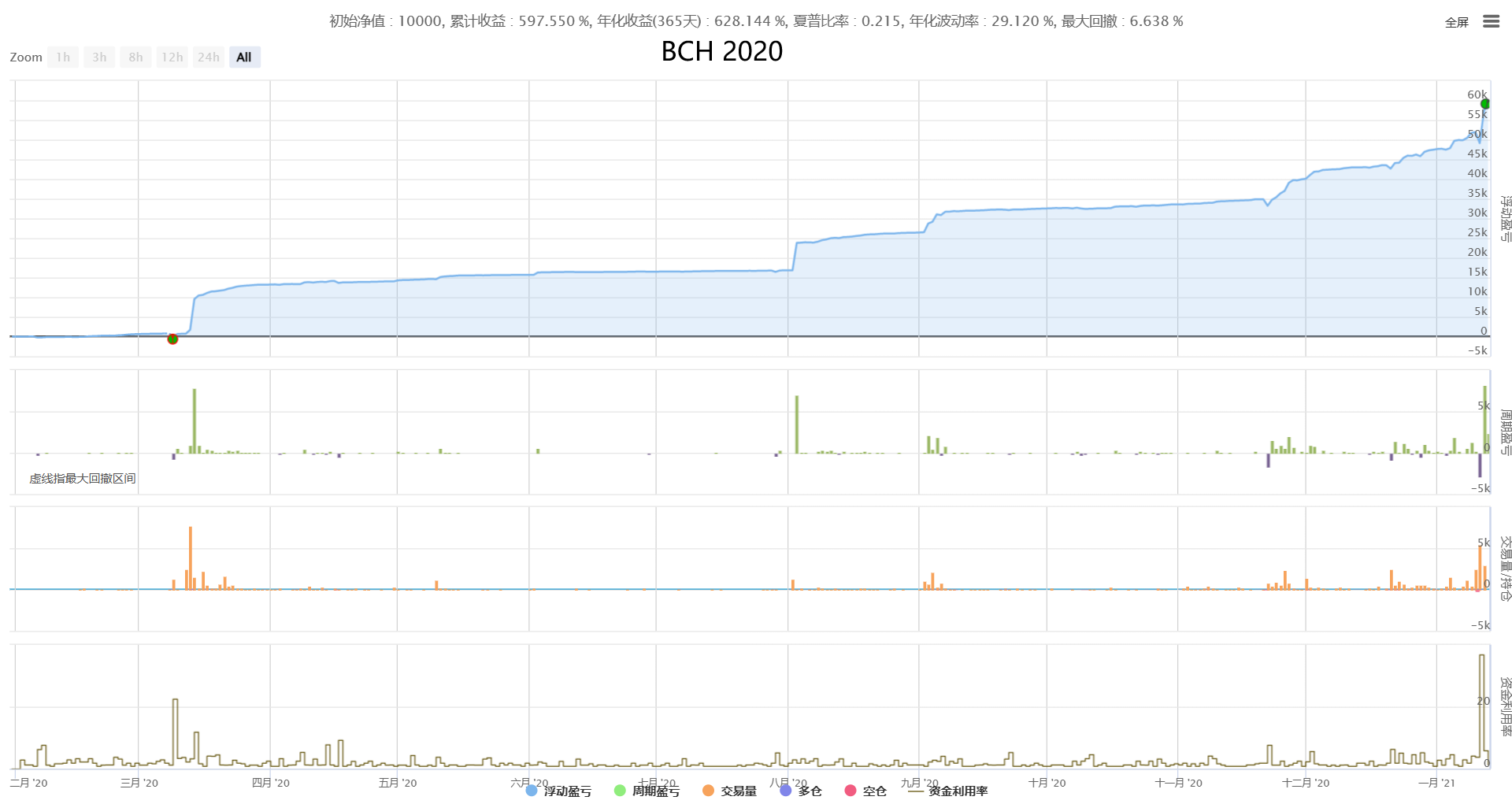
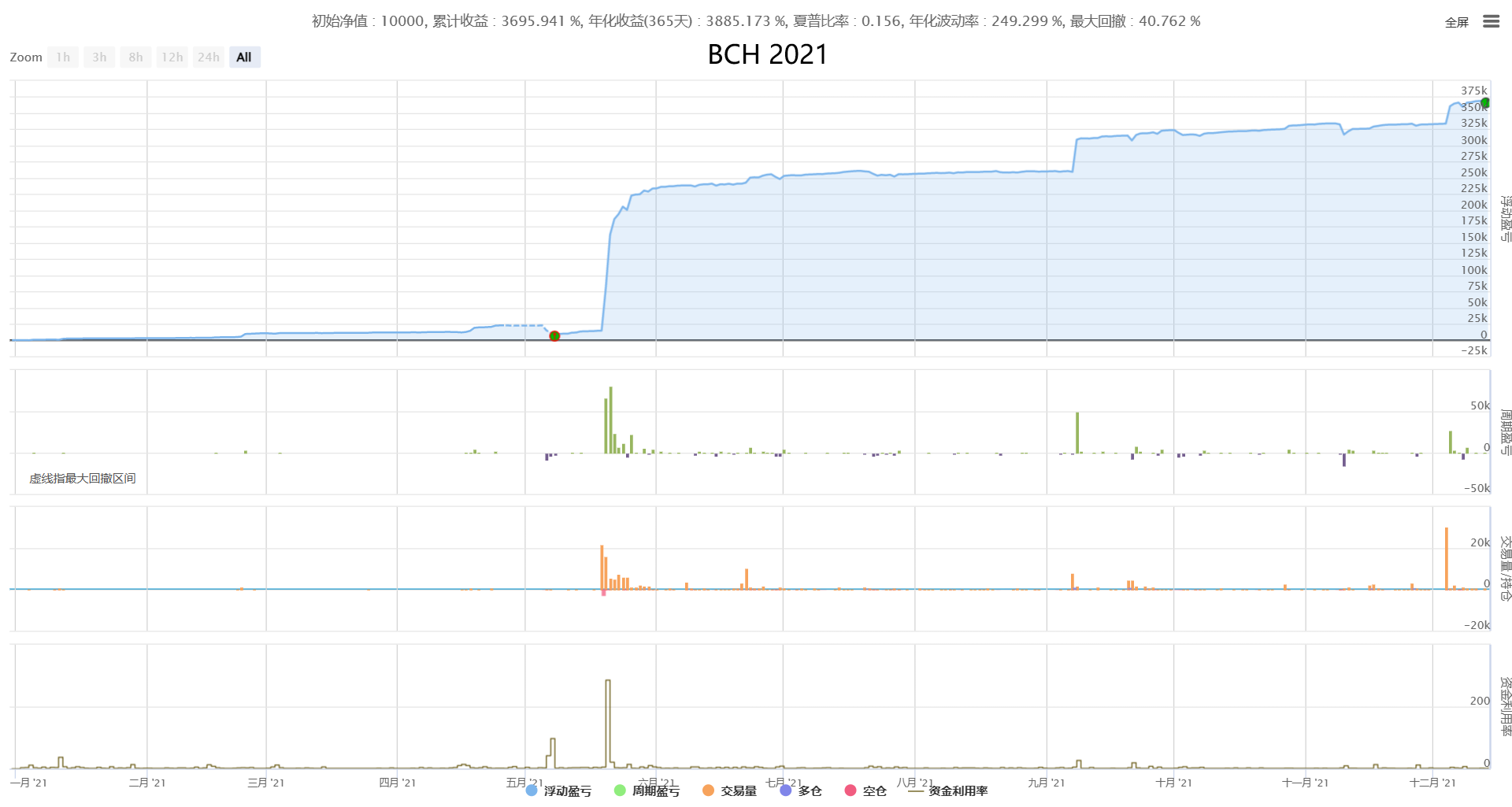
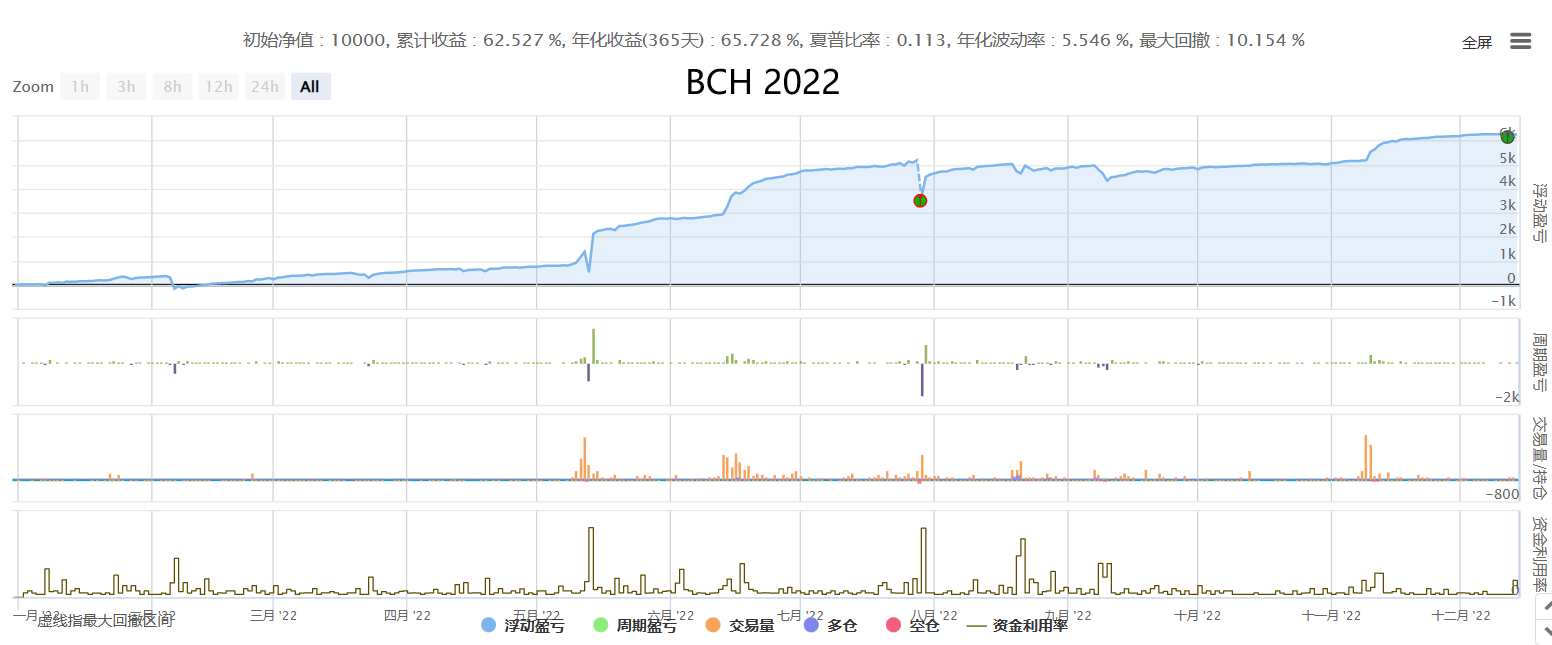
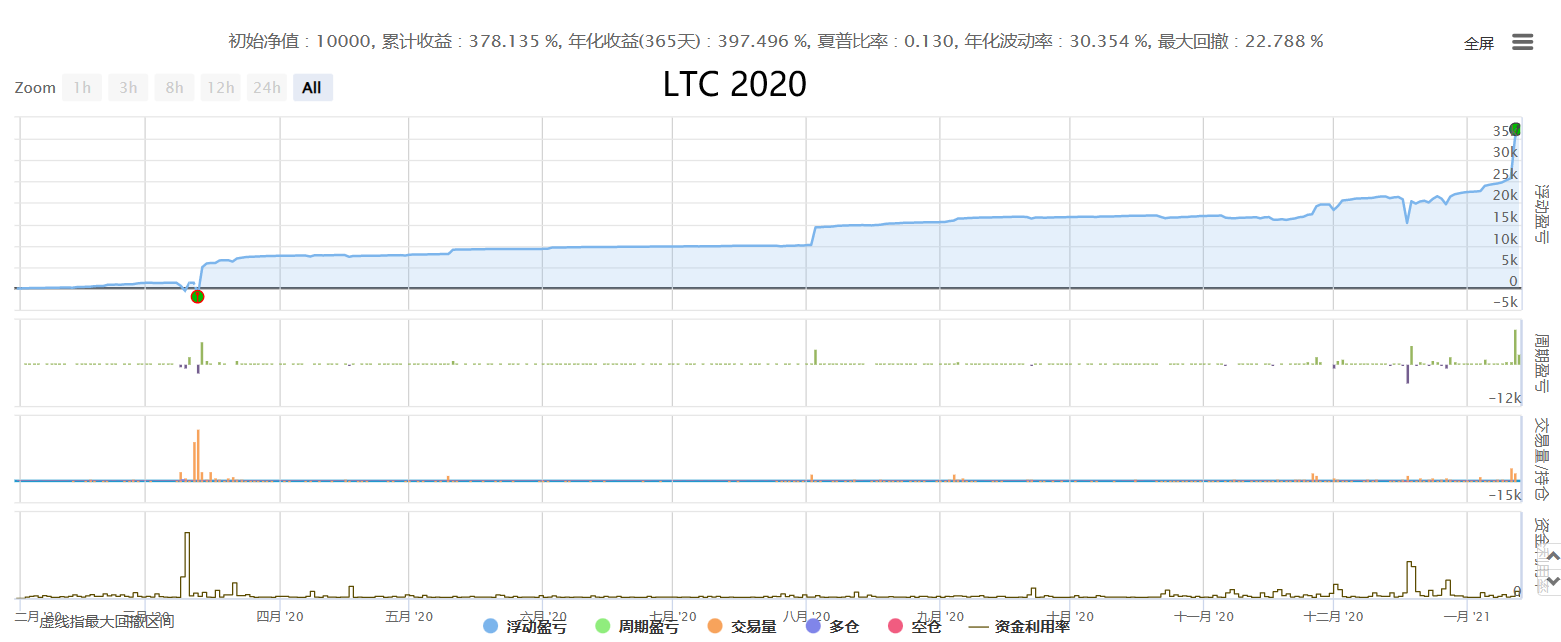
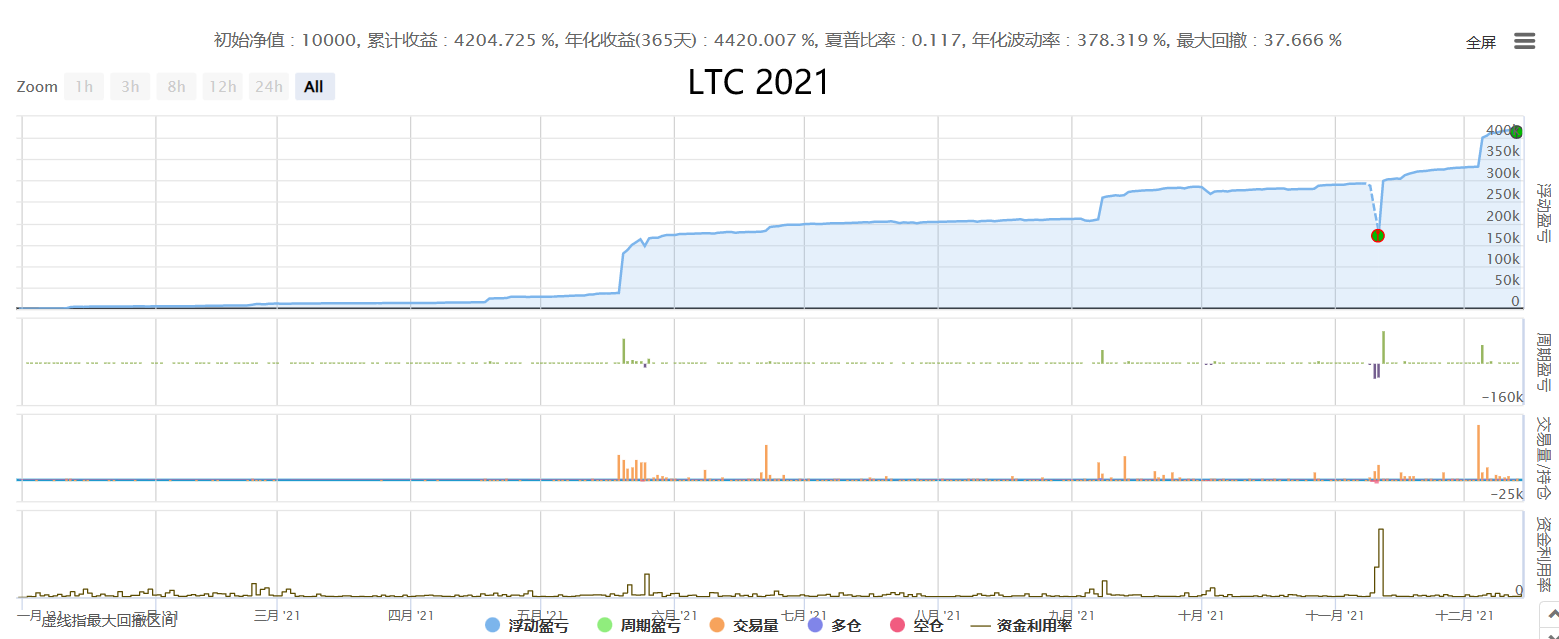
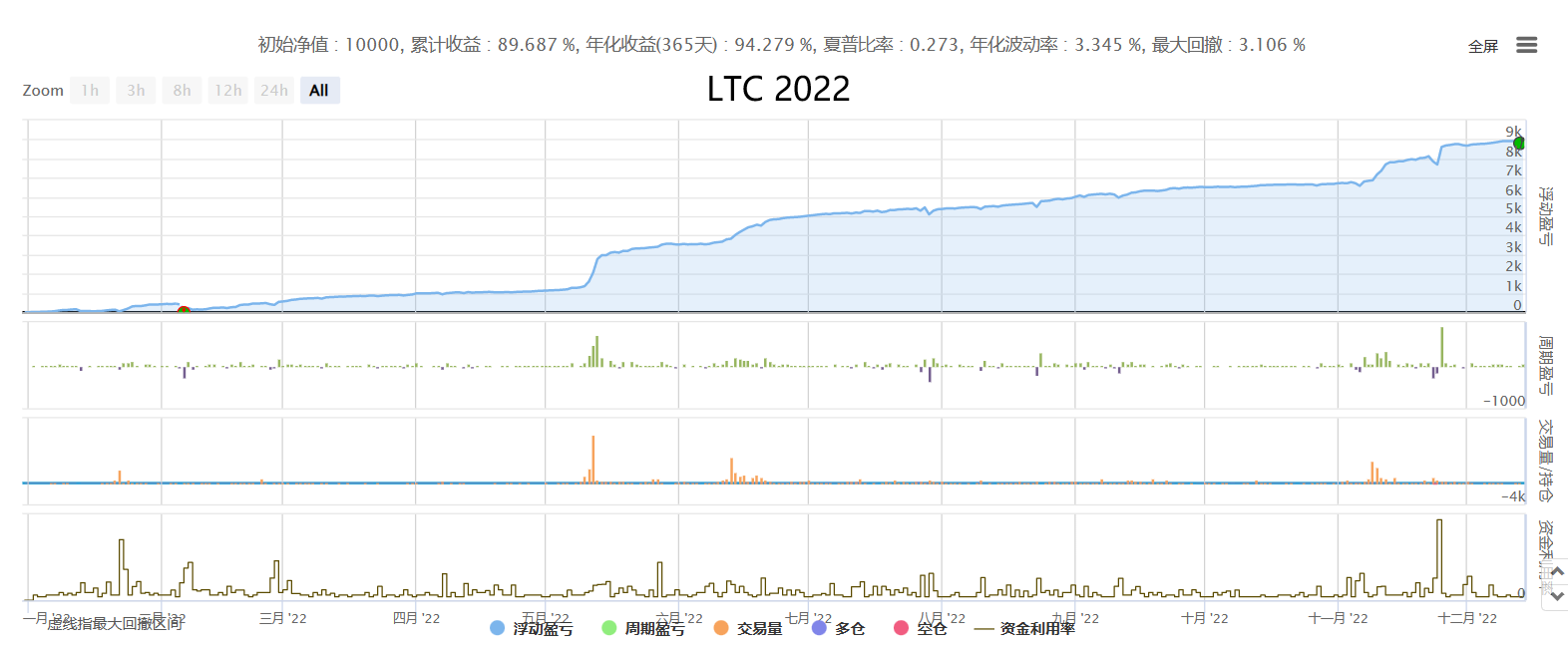
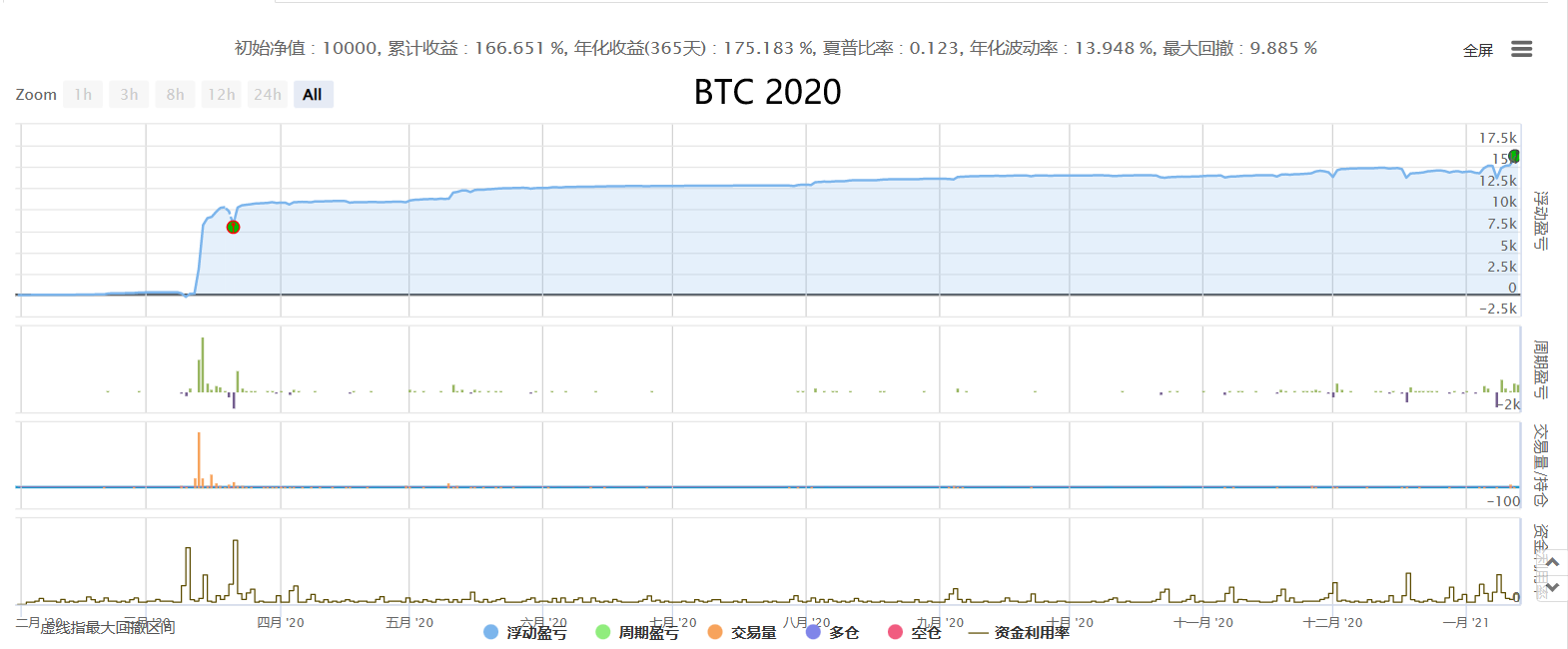
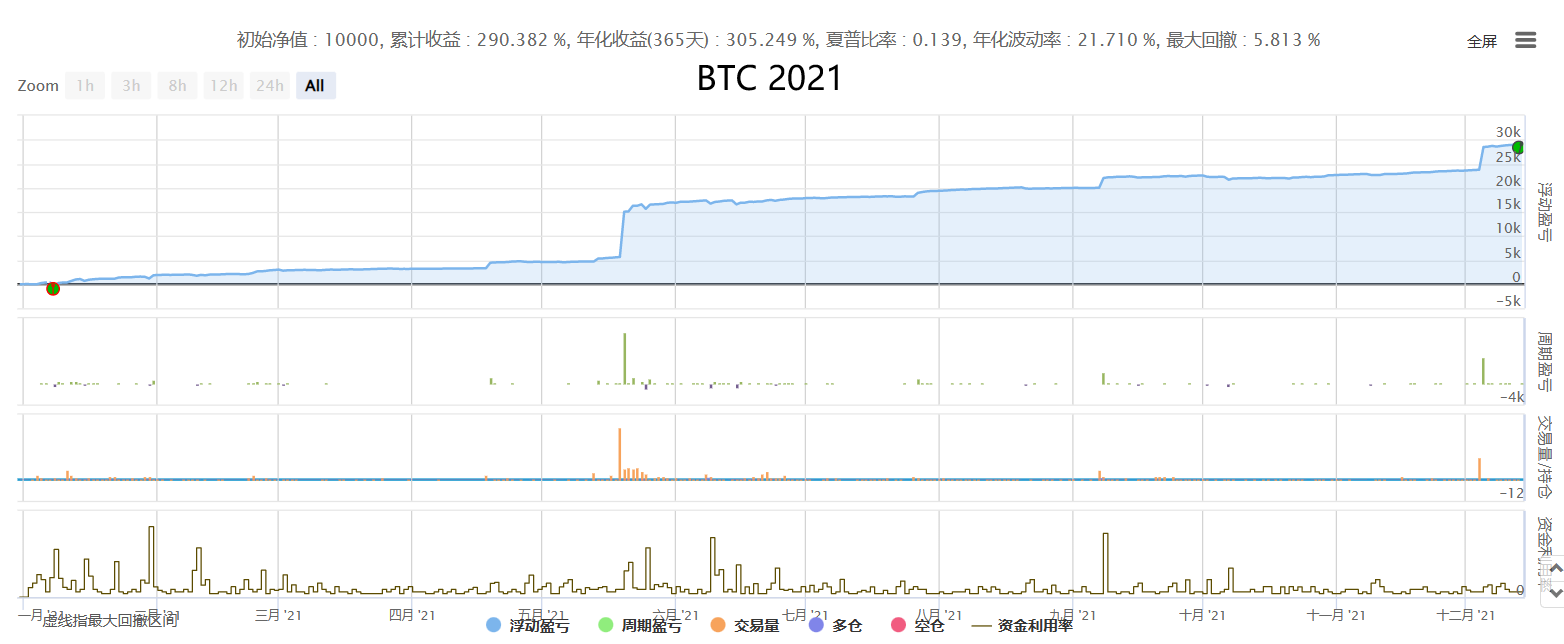
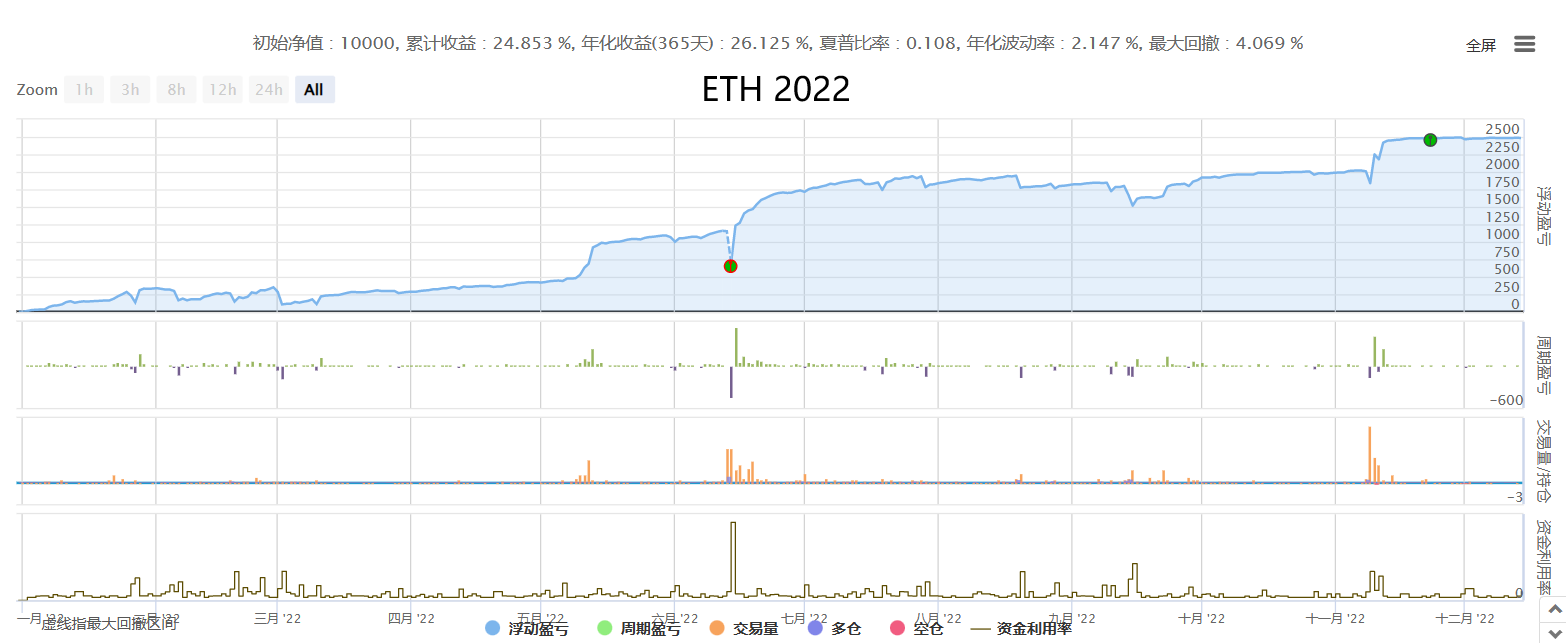
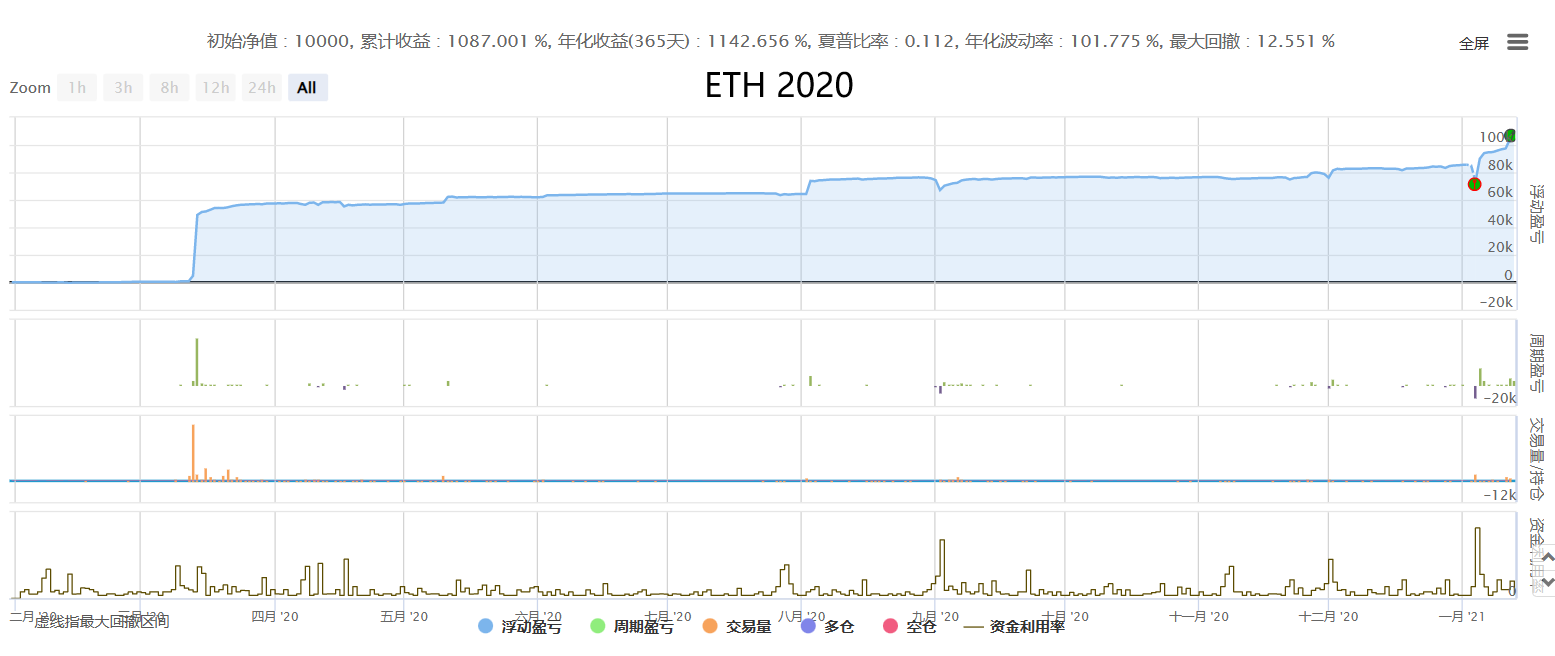
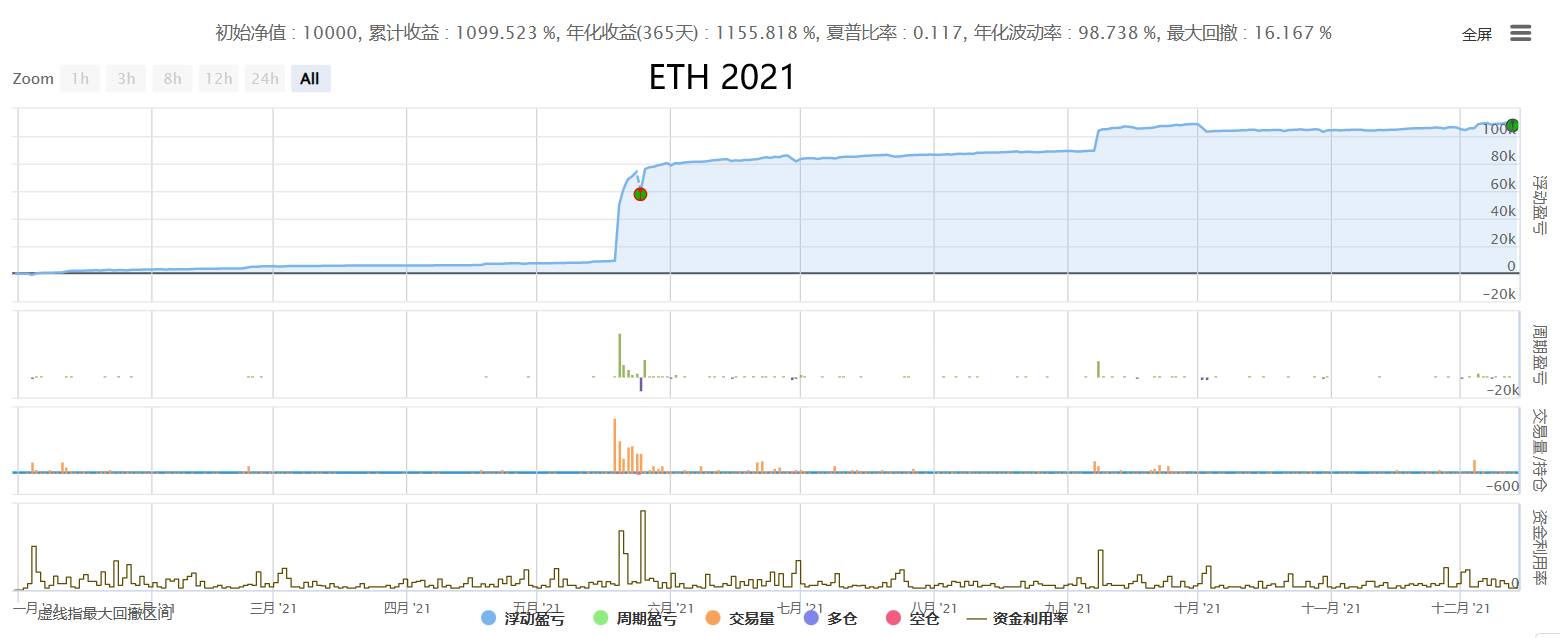
五,期待合作交流,共同学习进步
任何策略都有其方法论与适应与否的行情。例如均值回归策略依据市场随机游走等理论,动量趋势策略依据多种行为金融学理论市场存在肥尾波动的行情等。一定要了解其原理,依据其特性,适应其波动。同时策略的使用者一定要注意盈亏同源,更高的收益一定伴随着更高的风险,成熟的策略有其优势与弊端,合理的运用并扬长避短,知晓其对与错,合适与否行情下的完整表现,做到胸有成竹,宠辱不惊。
本款策略实盘地址: 【高频对冲做市网格New】(HFT Market-Making矿机版)-USDT矿机 【高频对冲做市网格New】(HFT Market-Making矿机版)-私人印钞机
合作方式:
量化不是永动机,也不是万能的,但它一定是未来交易的方向,值得每个交易者学习和使用!欢迎各位交易者前来指出不足,共同讨论,一起学习进步,在波澜壮阔的行情里乘风破浪,砥砺前行。
● 更多合作方案:对于任何有需求的个人与机构都保持开放共赢的合作态度,期待您的商讨,按您需求、风险偏好等定制化合作。
另外一款0多空敞口风险,长期稳健的中性对冲统计套利策略,在不暴露市场β性风险下,赚钱超额阿尔法的稳健策略: 【中性对冲统计套利New】(Pure-Alpha 梦幻版)
另外一款大容量中低频复合CTA交易系统,历时800天实盘,风雨无阻。是目前公布的时间最长、稳定性较高、普适性较强的CTA策略组合系统,以实现中长期稳定增长: 【复合CTA交易系统New】(多因子+多品种+多策略公用版)
✱ 联系方式 (欢迎交流讨论,共同学习进步) WECHAT: haiyanyydss Telegram: https://t.me/JadeRabbitcm 更多干货 ➔ 作手君的量化小屋 https://www.fmz.com/market-offer/512 ✱Fully automatic CTA & HFT & Arbitrage trading system @2018 - 2024